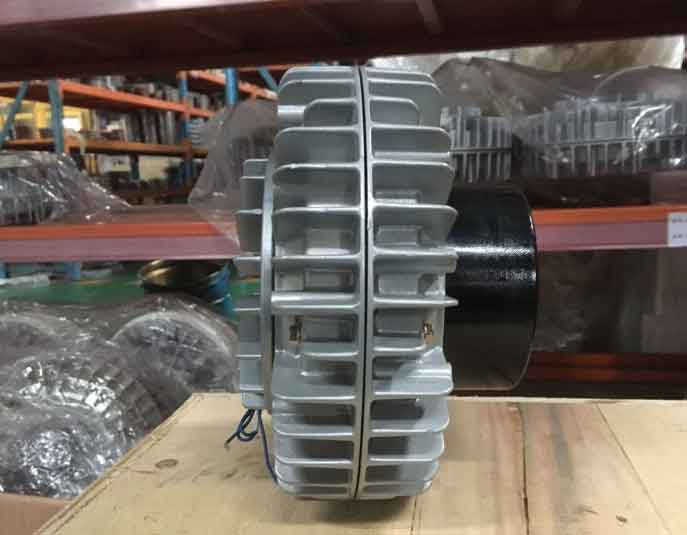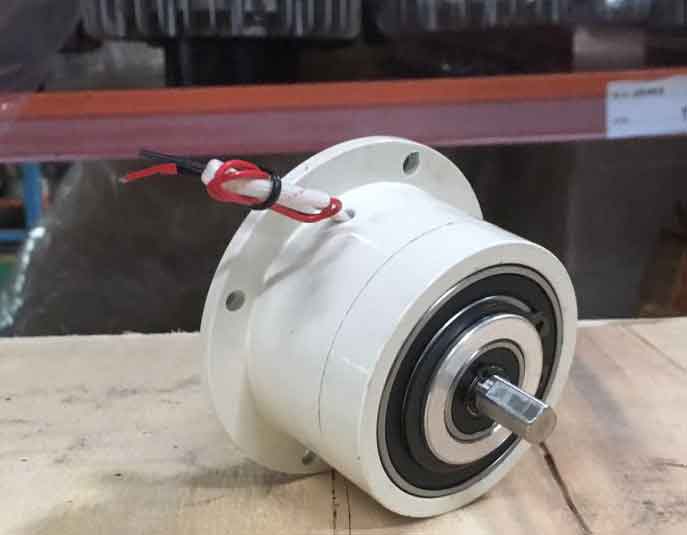The magnetic particle brake is a multi-purpose automatic control component based on the electromagnetic principle and using magnetic powder to transmit torque. It is widely used in braking, loading and unwinding tension control of various machine winding systems for different purposes.
Magnetic particle brake has the characteristics that the excitation current and the transmitted torque are basically linearly related. It can transmit a certain torque regardless of the slip. It has the advantages of fast response, simple structure, no pollution, no noise, no impact and vibration, etc.
Tension control systems play a vital role in various industrial applications, ensuring that materials like paper, film, and wire are processed with precision. Magnetic particle brakes are key components in these systems, offering a sophisticated method for controlling tension. In this article, we will delve into the working principles, applications, and advantages of magnetic particle brakes, shedding light on their crucial role in tension control.
Main Components Of Magnetic Particle Brake
Magnetic particle brakes are electromagnetic devices designed to provide controlled resistance to the rotation of a shaft. They consist of two primary components:
- Rotor: The rotor is typically connected to the input shaft and is responsible for transmitting torque.
- Stator: The stator is connected to the output shaft and contains electromagnetic coils.
These components work together to create a magnetic field that controls the torque transfer between the input and output shafts. The core of a magnetic particle brake is the magnetic powder within it, which plays a pivotal role in regulating this transfer.
Working Principle Of Magnetic Particle Brake
The working principle of a magnetic particle brake is based on the rheological behavior of magnetic particles suspended within the brake. When an electromagnetic coil is energized, it generates a magnetic field, causing the magnetic particles to align along the magnetic flux lines. This alignment results in an increase in the torque transmitted from the input shaft to the output shaft.
Conversely, reducing the current to the coil weakens the magnetic field, allowing the magnetic particles to return to their randomly distributed state. As a result, the torque transmission decreases. This controllable variation in torque is what makes magnetic particle brakes suitable for tension control systems.
Top 4 Applications Of Of Using Magnetic Particle Brakes In Tension Control Systems
Magnetic particle brakes find extensive applications across several industries, including:
1. Printing and Packaging
In printing and packaging machines, magnetic particle brakes help maintain consistent tension in materials such as paper, plastic film, and labels, ensuring precise and high-quality output.
2. Wire and Cable Manufacturing
In the wire and cable industry, these brakes are used to control the tension during the production process, ensuring uniform and defect-free products.
3. Textile Industry
Magnetic particle brakes find applications in textile machinery, regulating the tension in fabrics and threads, resulting in a high-quality end product.
4. Converting Machinery
Converting machinery for processes like slitting, laminating, and coating relies on magnetic particle brakes to control tension, preventing material damage and ensuring accuracy.
4 Major Advantages Of Using Magnetic Particle Brakes In Tension Control Systems
Magnetic particle brakes offer several advantages, making them a preferred choice in tension control systems:
- Precise Control : Magnetic particle brakes provide highly accurate and responsive tension control. Operators can fine-tune the tension as needed, ensuring consistent product quality.
- Non-Wearing : Unlike friction brakes, magnetic particle brakes are non-wearing, leading to minimal maintenance requirements and long-term cost savings.
- Overload Protection : These brakes can protect machinery from sudden overloads, preventing damage to the equipment and reducing downtime.
- Silent Operation : Magnetic particle brakes operate quietly, making them suitable for applications where noise is a concern.

Magnetic particle Brakes in Action
To better understand how magnetic particle brakes function in tension control systems, let’s consider a real-world scenario. Imagine a paper manufacturing machine that produces rolls of paper.
| Component | Function |
|---|---|
| Unwinding Roll | Magnetic particle brake applies tension control |
| Paper Manufacturing Line | Maintains uniform tension throughout the process |
| Rewinding System | Ensures consistent winding of the paper roll |
In this scenario, the magnetic particle brake is applied to the unwinding roll, where it controls the tension of the paper as it is fed into the manufacturing line. This ensures that the paper is processed smoothly without wrinkles or creases. The brake continues to maintain uniform tension throughout the process, resulting in a high-quality paper roll. Finally, at the rewinding system, the brake guarantees that the paper is consistently wound onto the roll.
Conclusion
Magnetic particle brakes are indispensable components in tension control systems, offering precise control, reliability, and a wide range of applications. Their ability to regulate tension in various industrial processes, from printing to textile manufacturing, makes them a cornerstone of modern production. As technology continues to advance, magnetic particle brakes are likely to play an even more significant role in ensuring the quality and efficiency of industrial processes. Understanding their principles and applications is vital for anyone involved in the manufacturing and processing industries.
